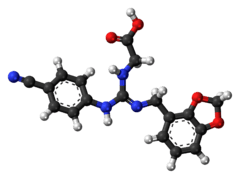Lugduname
Lugduname (from lat. Lugdunum for Lyon) is one of the most potent sweetening agents known.[1] Lugduname has been estimated to be between 220,000 and 300,000 times as sweet as sucrose (table sugar), with estimates varying between studies. It was developed at the University of Lyon, France in 1996.[1] Lugduname is part of a family of potent sweeteners which contain acetic acid functional groups attached to guanidine.[2][3]
 | |
 | |
| Names | |
|---|---|
| IUPAC name
N′-(4-Cyanophenyl)-N′′-(2,3-methylenedioxybenzyl)guanidinoacetic acid | |
| Identifiers | |
3D model (JSmol) |
|
| ChemSpider | |
PubChem CID |
|
CompTox Dashboard (EPA) |
|
| |
| |
| Properties | |
| C18H16N4O4 | |
| Molar mass | 352.350 g·mol−1 |
Except where otherwise noted, data are given for materials in their standard state (at 25 °C [77 °F], 100 kPa). | |
| Infobox references | |
References
- Hürter, T. (2004). "Wie wir schmecken". Technology Review. Heise.de. 2004 (4).
- Chen, J.; Pattarawarapan, M.; Zhang, A. J.; Burgess, K. (2000). "Solution- and Solid-Phase Syntheses of Substituted Guanidinocarboxylic Acids". Journal of Combinatorial Chemistry. 2 (3): 276–281. doi:10.1021/cc990084b. Contains a synthetic method for Lugduname, see Scheme 2
- Nofre, C.; Glaser, D.; Tinti, J.-M.; Wanner, M. (2002). "Gustatory responses of pigs to sixty compounds tasting sweet to humans". Journal of Animal Physiology and Animal Nutrition. 86 (3–4): 90–96. doi:10.1046/j.1439-0396.2002.00361.x.
This article is issued from Wikipedia. The text is licensed under Creative Commons - Attribution - Sharealike. Additional terms may apply for the media files.